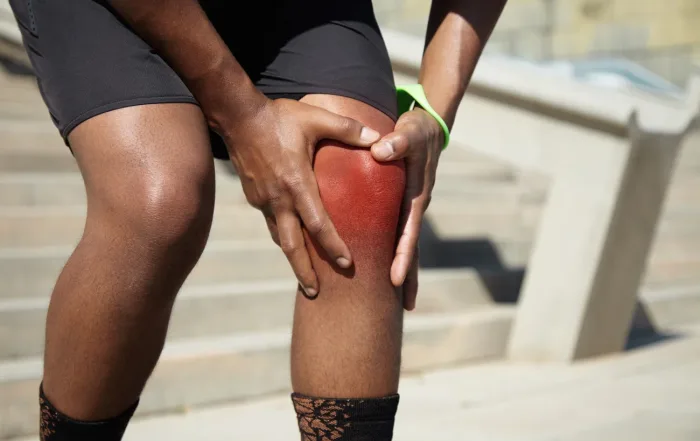Can you do Yoga After Hip Replacement Surgery?
5 Poses to Get you Started
[no_toc]
Getting Back into Yoga After your Hip Replacement
Should a total hip replacement keep you from practicing yoga? No, it should not. Granted, you may need to make some adjustments in some yoga movements and postures so that your recent hip replacement does not dislocate while you are building strength and flexibility.
Some yoga postures may be too intense to practice when you return to your yoga mat. In some cases, your instructor will guide you to “go deep” in yoga class. After surgery, however, you will need to take heed when you hear those words from your teacher. Instead of moving into deep stretches and other yoga positions, this is the opportunity to take advantage of another aspect of yoga practice: less is more.
In our everyday lives, we are encouraged to work at 110%, to do our absolute best all the time, to push hard. This is also experienced in the yoga classroom. Pushing to our limits, though, is not always beneficial to our mental and physical health. It may increase stress in the body and mind.
This is especially relevant after a major surgery like a hip replacement. Take a mindful approach after your doctor clears you for surgery. Be consciously aware of some of the new limitations you will experience at first. Know what types of movements will enhance or hinder the healing process. Your intention should focus on functional movement and alignment. The following will guide you through several standing yoga postures that not only helps with good posturing and movement but also proper strengthening and stretching.
Exercise Caution When Starting Yoga During your Recovery – Exercises to Avoid
Patients who undergo hip replacement should be careful with placing their hips in extremes of motion. Many yoga practitioners are more flexible than the average patient. It is important to talk with your orthopedic surgeon about your regimen prior to starting. Depending on the approach used, you may be limited in the types of activities you can do, especially for the first 6 weeks. A study performed at the University of Arkansas looked at different poses and the risk of hip dislocation during yoga.
If you undergo a hip from the posterior approach, you should initially avoid poses such as downward dog, forward fold, seated twist, and pigeon stressed the hip in flexion.
While the anterior hip replacement has a much lower risk of hip dislocation, it is recommended that you avoid poses that place your hip in extension. Poses to be careful of include warrior 1, warrior 2, crescent lunge, pigeon, and triangle. Eagle and seated twist put the hip in higher adduction, while half-moon, eagle, and triangle produced more hip internal rotation
Yoga Poses to Help with Hip Replacement Recovery
These are common yoga postures but performed with a variation that focuses on health and safety after a total hip replacement. As you start your yoga practice, always consult with your doctor and a physical therapist so that your recovery continues to progress toward full recuperation.
Mountain Pose
This is a standard yet remarkably effective yoga posture when it comes to practicing alignment throughout the body. Start by standing near the top of your yoga mat. As it feels comfortable, stand with your feet about hip-distance apart with your toes pointing forward. If you need to make a slight adjustment with this stance, please do so. You want to feel both feet firmly connect to the ground and create an even distribution of weight across both sides of the body. Keep your gaze forward and roll your shoulders back. This will create an improved posture and a full length in your spine. With your arms down by your side, turn your palms to face forward. This, too, will enhance your overall upper body posturing. Hold this position for 10-20 slow deep breaths. This allows your body to assimilate to the alignment you are practicing.

Extended Mountain Pose
After you have held Mountain Pose for the assigned set of breaths, you can add a simple movement. Take a full inhale and extend both arms into the air. Treat it like a nice stretch; feel the stretch through the sides of your body as well as the lengthening in your spine. This is Extended Mountain Pose. Exhale to lower your arms back down by your side. Repeat this movement 5 times. To create more stability in your body, you will want to engage your core muscles. As you exhale to lower your arms, draw your navel inward toward your spine to activate your abdominal muscles. This is called the Abdominal Lock. This allows for greater support throughout your body. It is highly effective in a stationary pose like Mountain Pose, but also when moving from pose to pose.

Half Forward Fold
For safety, you may want to perform this next posture using a wall or the back of a chair as a prop for support. It is Half Forward Fold. It creates a stretch through your hamstrings, lengthens the spine, and gently releases the hips without moving past a 90-degree angle. Start by stepping back a few feet away from a wall or the high back chair. Inhale to raise your arms overhead. As you exhale, place a slight bend in your knees, and slowly fold forward with your hands on the wall or chair to safely come down to just shy of parallel to the floor. Adjust the body as needed so you can hold this position for several breaths. You will want to experience a lengthening down the backs of your legs. In addition to that, notice the stretch through the sides of your body as you lengthen your spine. This posture will have minimal impact on your hips, but you will still gain positive benefits in your upper and lower body.

Tree Pose
Another standing posture, Tree Pose, can help with balance and gently open the hips. Still using the back of a chair or wall for balance, stand with your right side facing your prop. Carefully shift your weight into your right foot. Use the chair or wall to stabilize your body. Slowly slide your left foot up the side of your right leg. Be mindful of how high you can slide your foot upward. In some cases, it may be best to keep your toes on the floor with just your heel touching the inside your right ankle. This will keep your leg from bending more than 90 degrees. Carefully turn your knee outward. Pay attention to the outer rotation that occurs in the hip; this should be a minimal movement to remain safe. Hold this posture for 5-10 breaths then perform the pose on the other side.

Warrior 2
Another standing pose that can positively supply strength and agility in the hips and legs is Warrior 2. Start in Mountain Pose. (You can still use a wall or chair for added support.) Step your left foot back no more than two feet. Turn your foot and leg outward about 45 degrees. As you are able, keep your back leg straight. Bend your right knee to less than 90 degrees. Be sure to keep your knee tracking over your heel or ankle bone for structural support in this front leg. Extend your arms over your legs; they will be parallel to the ground.
Having a short distance between the feet for this variation protects your hips so they do not overstretch. Hold your posture for 5-10 breaths. Warrior 2 opens the upper body as well as opens the hips safely. With the lunging front leg, you strengthen your quadricep muscle and outer hip. After your series of breaths, practice the pose on the other side.

Talk with Your Hip Replacement Today!
Choose Dr. Morton as your Hip Replacement Surgeon Today!
- Board-certified, Fellowship Trained Hip Surgeon
- Experienced Orthopedic Surgeon
- Nonoperative and operative treatments available
- High success rate in rapid-recovery techniques
- Able to perform different approaches to the hip
- Minimally invasive surgery
- Well-versed with yoga techniques for recovering from hip replacement surgery
- Fellowship-trained and specialist in hip replacement surgery
- Understands your desire to get back to activity
The Role of PRP in Treating Sports Injuries for Athletes
In the competitive world of sports, athletes constantly push their bodies to the limit, which, unfortunately, often leads to injuries. The quest for effective and swift recovery solutions is ongoing from tendonitis and [...]
Yoga After Knee Replacement Surgery
To regain your strength after a knee replacement surgery, turn towards yoga and practice these poses that work wonders to win back your mobility and strength.
Yoga after Hip Replacement
Can you do Yoga After Hip Replacement Surgery? 5 Poses to Get you Started [no_toc] (808)439-6201 The Queen’s Medical Center POB [...]








